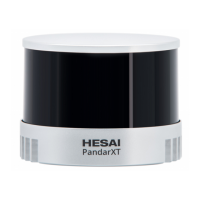1.2.2. Bottom connector lidar
Figure 4. Coordinate system (isometric view) Figure 5. Lidar azimuthal position (top view)
•
The lidar's coordinate system is illustrated in Figure 2. Coordinate system (isometric view) and Figure 4. Coordinate system (isometric view). Z-axis
is the axis of rotation.
•
Lidar azimuthal position is defined in Figure 3. Lidar azimuthal position (top view) and Figure 5. Lidar azimuthal position (top view). Y-axis
corresponds to 0°.
•
Each laser channel has an intrinsic azimuth offset. All channels are selected to define the lidar's azimuthal position.
For example, when all channels pass the 90° position:
•
the lidar is at the 90° position;
•
the Azimuth field in the corresponding data block in the Point Cloud Data Packet will be 90°.
-12-

